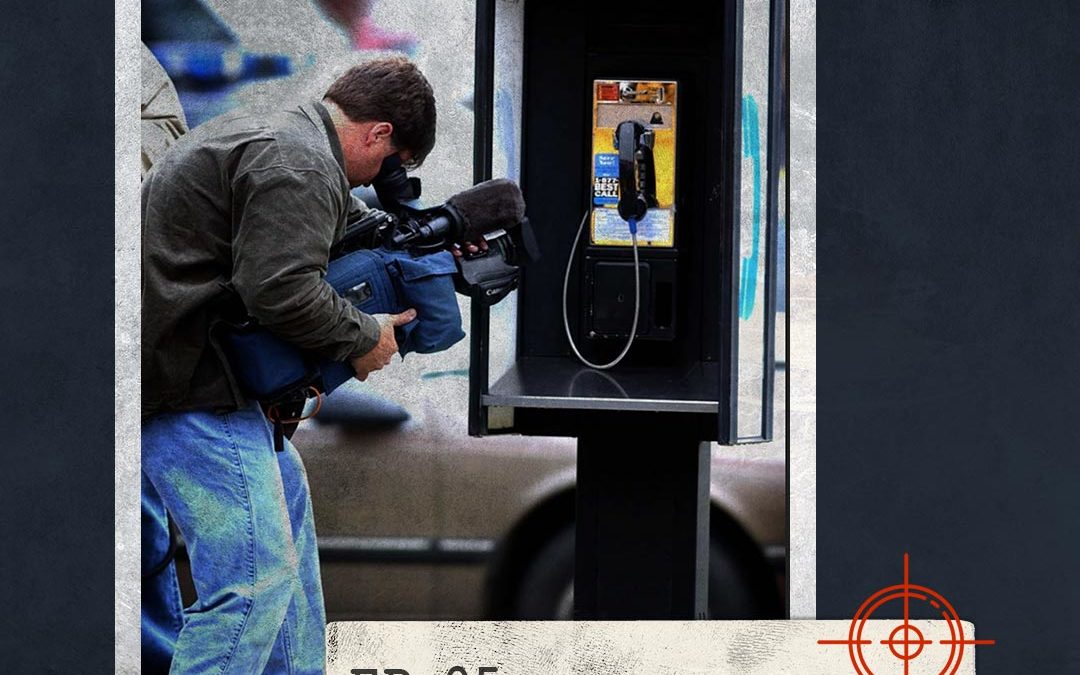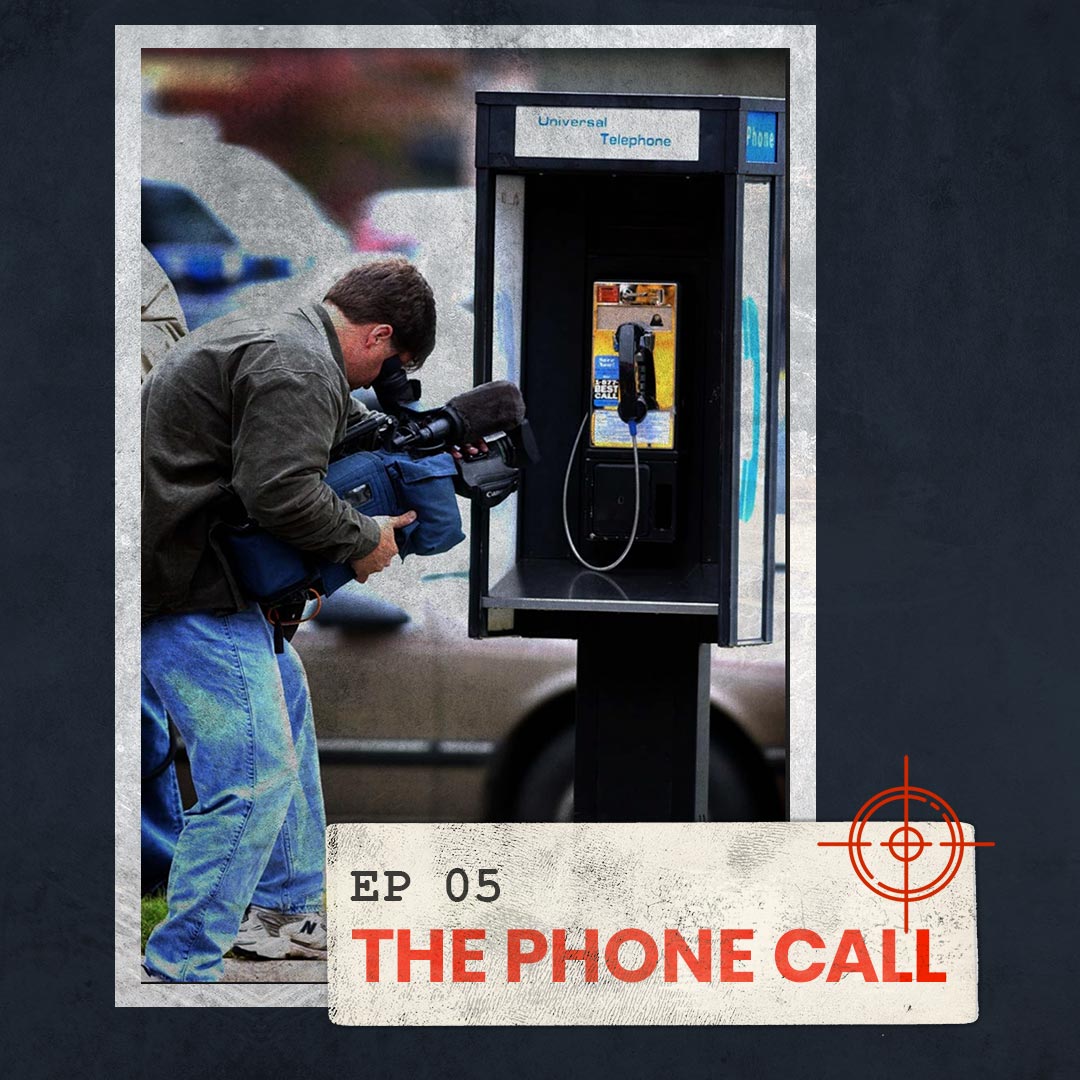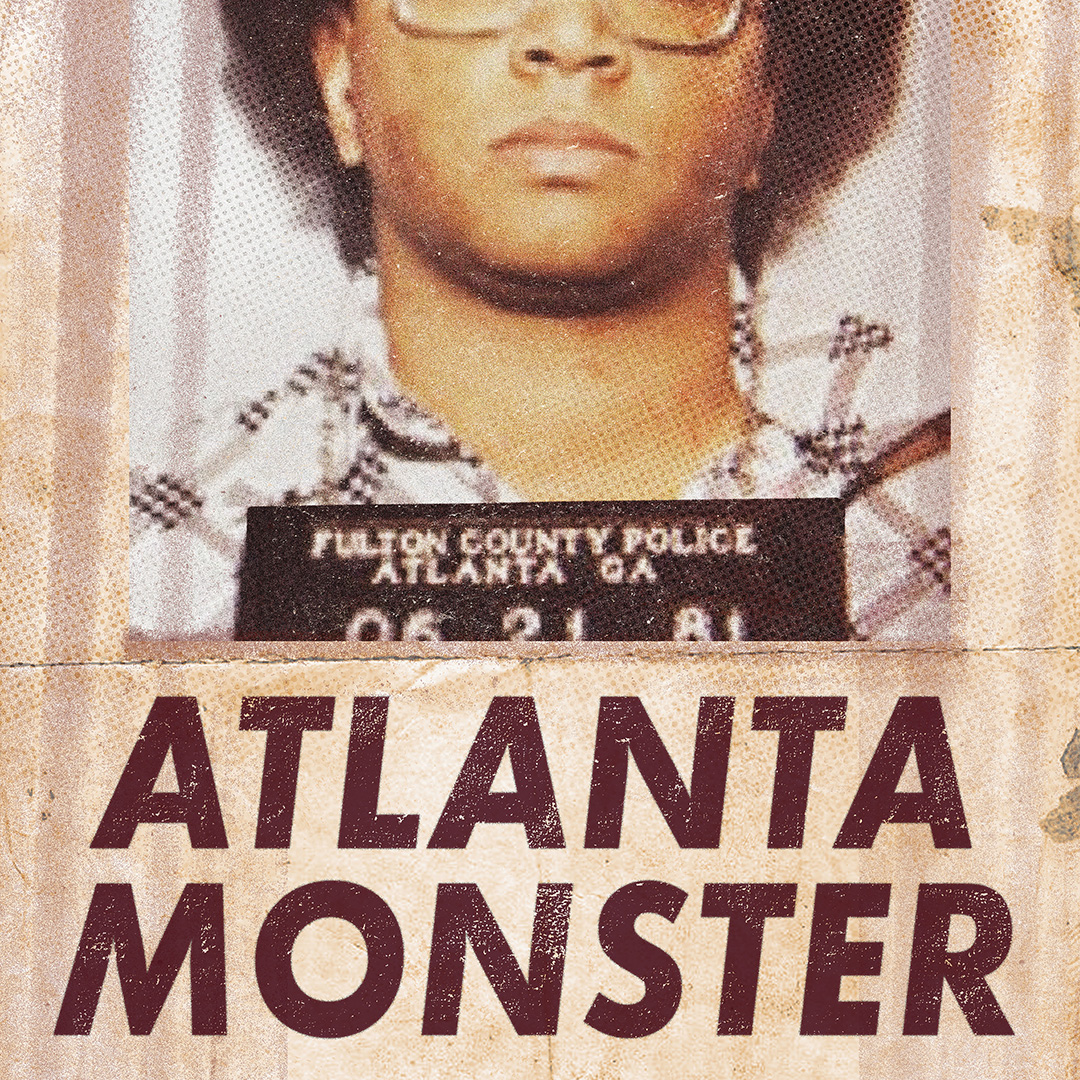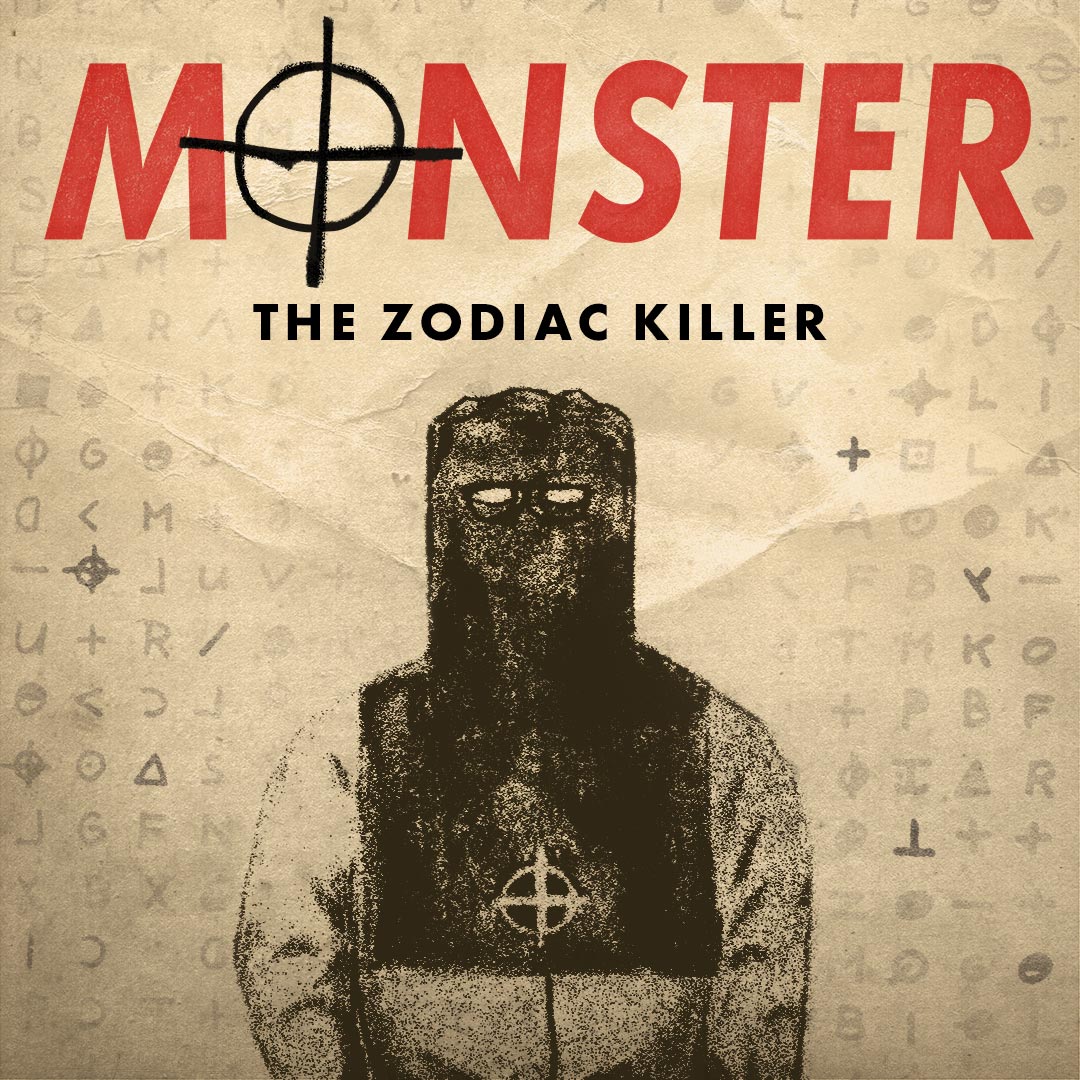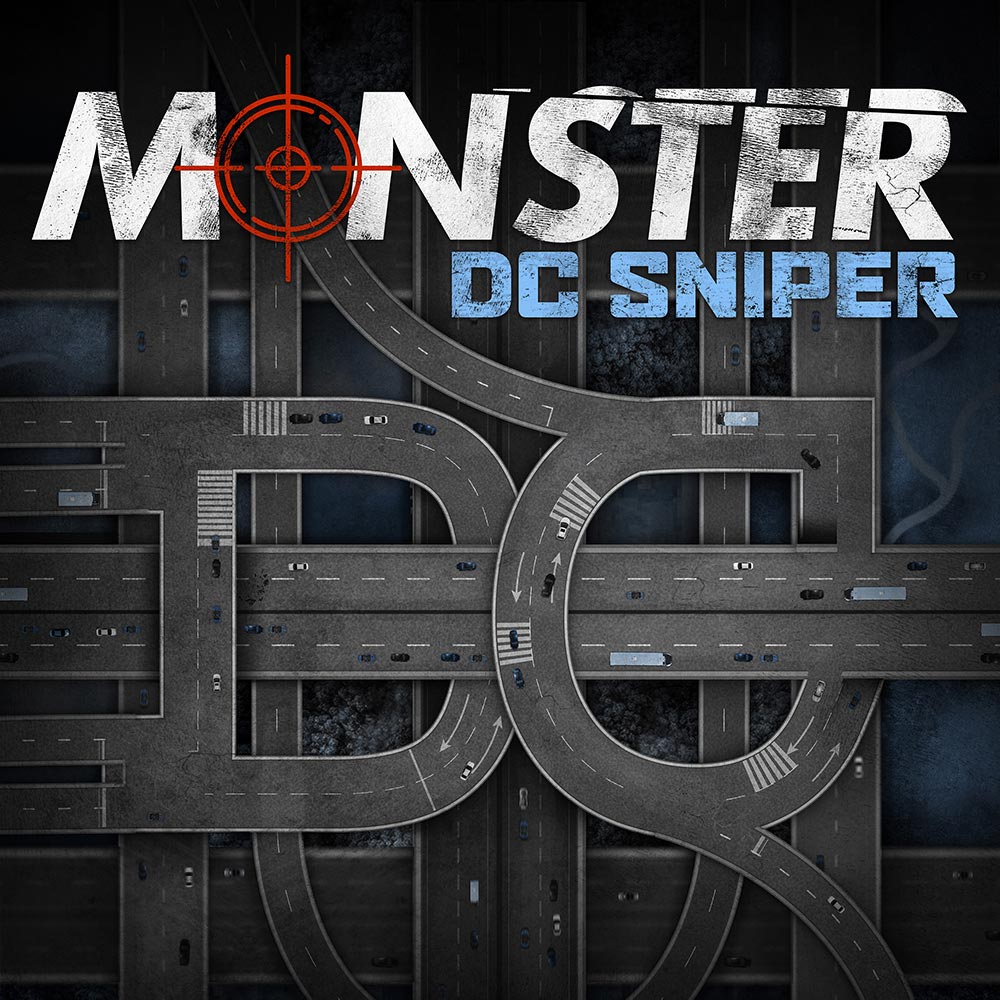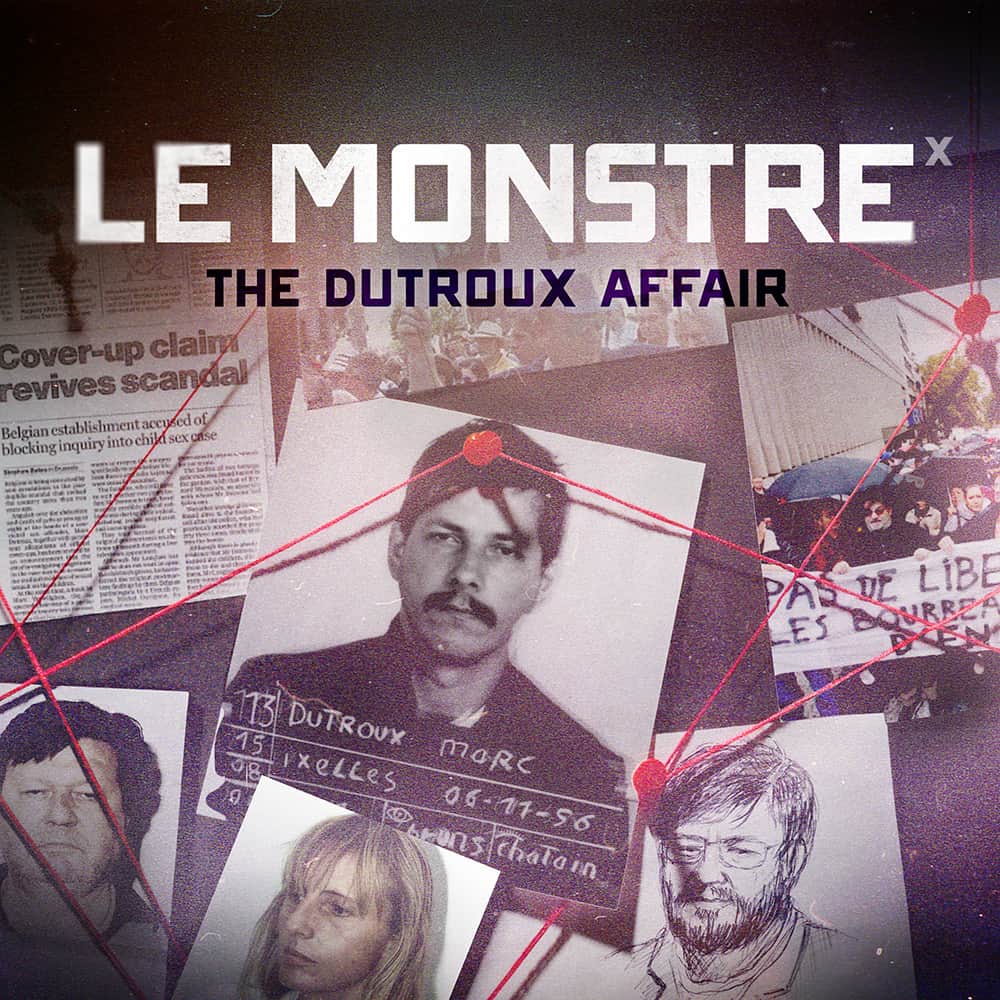5 • THE PHONE CALL
On October 19th, a victim survives another attack outside of a steakhouse. And police get a phone call from the sniper.
Transcript
Speaker 1: 00:00 Welcome to Monster: DC Sniper, a production of iHeartRadio and Tenderfoot TV. The views and opinions expressed in this podcast are solely those of the podcast author or individuals participating in the podcast, and do not represent those of iHeartMedia, Tenderfoot TV, or their employees. Listener discretion is advised.
Tony Harris: 00:21 October 19th, 8:00 P.M., Ashland, Virginia. 37-year-old Jeffrey Hopper was walking with his wife Stephanie. They were in the parking lot outside of Ponderosa Steakhouse, when a shot rang out from the woods. Tim Meacham was the first officer on the scene.
Ofc. Meacham: 00:44 In 2002, I was a patrol officer with the Ashland Police Department.
Speaker 4: 00:48 We’re walking in the parking lot of the Ponderosa.
Ofc. Meacham: 00:51 Right.
Speaker 4: 00:52 So, put me back in the time and space. Walk me through it.
Ofc. Meacham: 00:57 I had received a call for a stolen or a lost cell phone, so I was taking that report a couple miles south of here. He was asking, you know, “What have you heard about this whole sniper thing?” And I was like, “I’ve heard as much as you have. I get the news.” And he looked at me and says, “Wouldn’t it be something if that guy came here?” And he had just finished saying that, when dispatch handed me the call. They said, “Respond to 817 England Street for a possible shooting.” I looked at him, like, “No way,” and the look on his face was priceless. You know, just like, “Oh my gosh. What did I just do to you?”
Ofc. Meacham: 01:36 I marked en route, told them I was on my way. They said, “We’ve had one call. We’ve got a male down in the parking lot at the Ponderosa.” I asked them if there was any other information, and they said, “No new calls, no new information.” That’s when I called the sergeant on the radio, and I said, “We may want to consider starting the response plan.”
Ofc. Meacham: 02:00 When I arrived, our victim was laying in the parking lot, and his wife was sitting on the sidewalk and had her husband’s head in her lap. I pulled past them, right to the end of the sidewalk here, and my car acted as a shield between the woods and the Hoppers.
Speaker 4: 02:18 So, instinctively you just pull your car into a position that sets up a barrier between the wooded area, and potentially more victims.
Ofc. Meacham: 02:28 Yes. Jeff was laying in the parking lot, and Stephanie was sitting on the sidewalk, and she was holding pressure on his stomach. I told her that I needed to verify the injury, so she lifted up the towel that she was holding on him, and I saw a hole about the size of a nickel in the top of the victim’s stomach.
Ofc. Meacham: 02:52 I feel somebody tap me on the shoulder. I wasn’t expecting anybody. Turn around. A guy standing there who’s a little bit shorter than me. He had a chain around his neck, and he reached into his shirt and he pulled it out, and it was a New York Police Department badge. He says, “I’m retired. What do you need?” If there was somebody still here, I wanted them to think that we were searching for him. I asked him to use the spotlight on my car to pan back and forth across the woods, and I showed him where the shotgun release was in my car, and told him that, “Hey.” If shots were fired, [inaudible 00:03:29].
continue reading
Speaker 5: 03:31 There is a ruthless person on the loose.
Speaker 6: 03:34 What unnerves this community the most is the randomness of the murders. Ordinary people, doing ordinary things.
Speaker 7: 03:41 They killed the five people in one day, and then went on the rampage for the next month.
Speaker 8: 03:47 It is quite a mystery. The police say they have never had a crime quite like this.
Speaker 9: 03:51 Be careful. These guys are using weapons that are going to go right straight through our bulletproof vests.
Speaker 10: 03:58 There’s a white van just went by, with two guys in it.
Speaker 11: 04:01 From iHeartRadio and Tenderfoot TV, this is Monster: DC Sniper.
Speaker 4: 04:11 Jeff and Stephanie. Describe the two of them, and how they were working through this very serious situation together.
Ofc. Meacham: 04:19 She was the calmest person I’ve ever seen on any type of major scene like this. And when you have somebody that’s bleeding internally like that, their heart rate is up, their blood pressure is up. It can make them bleed out a little bit faster. But Jeff was laying there, just staying really calm. I told her, I said, “Okay. The best thing to do for a bleed is just to hold pressure, and it’s not rocket science.” She started to chuckle. The victim started to laugh. At this point, I’m like, “Okay. Can you guys let me in on the joke?” Well, she was a rocket scientist for NASA, so me telling her that it wasn’t rocket science… Eh. She kind of knew that already. They actually told me that they were in Pennsylvania visiting family. Intentionally, they didn’t stop in Maryland, D.C. or northern Virginia because of the shootings, and they felt like if they stopped closer to Richmond, they would be safer.
Ofc. Meacham: 05:13 So the ambulance, when they come up on scene, normally wait until law enforcement can make sure the scene is safe for them to enter. I couldn’t do that, so we came up with a different plan for them to come in and pick up Jeff. I got my shotgun. I told the driver of the ambulance to stay in the driver’s seat. I had the crew of the ambulance come out of the back of the ambulance. I had them park right behind my car, bumper to bumper, so that the ambulance itself was also some type of barricade. They get Jeff on the stretcher, they put him in the ambulance, and we get them out onto England Street and tell them to take the shoulder of Interstate 95, because we had shut it down.
Tony Harris: 05:51 By 8:30, the victim was arriving at the hospital, and police across this area had activated a coordinated tactical response, a plan put in place just last week, in the event of a suspected sniper attack.
Lt. D. R.: 06:04 Very quickly, traffic was brought to a complete stop.
Tony Harris: 06:08 That’s retired Maryland State Police Lieutenant David Reichenbaugh.
Lt. D. R.: 06:12 Ordinarily if you do that, you’ve got phone calls going to politicians. “Hey, what’s going on? Why are the roads blocked? I can’t get home. I can’t go about my business.” But believe it or not, at this point the public was completely onboard with law enforcement. They were in fear. They wanted this stopped as badly as we did.
Tony Harris: 06:33 The roadblocks turned up nothing. The sniper had vanished once again. But there was good news. Thanks to the efforts of first responders, Jeffrey Hopper survived the attack.
Ofc. Meacham: 06:44 Once we got Jeff in the ambulance, we got the crime scene tape out. And we just, right in front of the Ponderosa, right on England Street, we taped from one side of the building to the other. From that point, it seemed like every three-letter agency in the federal government was starting to show up. I had FBI show up. I had ATF show up.
Tony Harris: 07:04 One of those ATF agents was Ray Neely.
Spc. Agt. Neely: 07:08 I’m a normal Special Agent. Well, I meant a relatively normal Special Agent. You know, I’m so used to hanging around law enforcement, Special Agents are kind of a dime a dozen. And I was based out of Washington, so it’s not very impressive in that particular area, anyway.
Tony Harris: 07:25 Ray Neely was a K-9 handler for the ATF.
Spc. Agt. Neely: 07:28 In 2002, during the sniper investigation, I handled a dog named Garrett, who was a yellow Lab. At that point he was about seven years old. We used the term Explosive Detection Canines. That’s their official title. In the public, you’ll just hear them called bomb dogs. It’s been estimated that there’s over 19,000 different types of explosive formulations, but generally they can be broken down into seven families. So, as long as you train across those seven families, the dogs can then find firearms as well as explosives.
Tony Harris: 08:03 On the night of October 19th, after Jeffrey Hopper was shot, the ATF sent Ray Neely to investigate the woods outside the Ponderosa.
Spc. Agt. Neely: 08:12 When we arrived that evening, it was actually kind of a balmy night. Because we’re working in low light, the human search was really not going to be effective, so they were going to wait til daybreak. I talked to the people on the scene and said, “Hey, it’s best that we deploy this evening. The dog doesn’t need daylight to work, and the odor scent is stronger now than it’s going to be tomorrow morning.”
Spc. Agt. Neely: 08:37 There was a wooded lot behind the Ponderosa. It’s all pitch black dark. When any human or animals move through wooded areas, they typically go through the area of least resistance. It’s called lines of drift. If there’s briars, the people are going to avoid that. They’re going to go a different path. And so, in this particular wooded area, I saw maybe three or four of these little breaks in the wood line. You know, they were animal trails, or maybe kids played in those woods. So I was going to search those first, and then if that failed, then I would start doing more of a gridded search.
Spc. Agt. Neely: 09:12 It was only on my second path of least resistance that I saw the dog change behavior. The dog started tracking until he went to a particular spot, and then he alerted me. I went over with my flashlight and examined the area where he looked, and that’s when I saw the rub mark. There was a small tree, about maybe two inches in diameter, with a small vine. When I looked up that tree, it looked like someone had taken some type of hard object and leaned it up against that tree, and that created a rub mark. You wouldn’t have that occurring in nature. You needed something hard pressing against it. It was also in the line of sight to where the person was actually hit, as he exited the Ponderosa. And so, that rub mark was someone probably using that tree as a rifle rest.
Spc. Agt. Neely: 10:03 I knew that the type of rifle more than likely would eject that shell casing to the right rear, so I deployed the dog off to my right rear, hoping to find that shell casing. Again, I saw him change behavior. Now he’s going directly to source. It was probably 20 feet away. And when he alerted this time, I went over with my flashlight. The shell casings can disappear in the ground pretty quick. The leaves had fallen off the trees at that point. But I actually saw the shell casing. It was sitting right on top. You know, pristine. But to the rear of where the shell casing was found, there was some type of message attached to a tree.
Tony Harris: 11:00 In the woods outside the Ponderosa Steakhouse, ATF Agent Ray Neely found a spent shell casing, along with another clue, one that would prove vital to solving the case.
Spc. Agt. Neely: 11:12 There was a message that was attached to a tree.
Tony Harris: 11:15 Investigators found a Ziploc bag pinned to a tree with two thumbtacks, and inside there was a letter. Investigators wanted to read the note, but they couldn’t just open the bag at the crime scene and risk contaminating the evidence.
Spc. Agt. Neely: 11:30 An FBI helicopter was brought in that evening to take that piece of evidence directly to the lab. They would be looking for DNA, any fingerprints.
Tony Harris: 11:40 The letter arrived at the lab the next morning, Sunday October 20th. When investigators finally opened it, they were shocked by what they found. Here is Maryland State Police Lieutenant David Reichenbaugh.
Lt. D. R.: 11:51 Again, the snipers did not want the press notified about this, and for the first time we were actually successful in preventing that. There was a couple significant things about this note. The first one was it was handwritten, and within a few hours, the handwriting on the tarot card that had been found a few days before was matched, so we knew we had the same individual. And any thought that it was organized terrorism pretty much got shot down and went out the window. The note had little red stars. When I say stars, if you’ve ever had a child that went to a daycare, and they bring their papers home and they did something great, the teachers put little silvery or gold or the red stars on top of their papers. That’s what I’m talking about. No self-respecting terrorist is going to do that, number one. Number two, we finally get a demand.
Tony Harris: 12:45 Here’s what the snipers wrote in the letter.
Snipers: 12:49 “For you, Mr. Police, call me God. Do not release to the press. We have tried to contact you to start a negotiation, but the incompetence of your force is these people took our call for a hoax or a joke.”
Tony Harris: 13:02 The letter then listed five people the sniper had contacted.
Snipers: 13:06 “One, Montgomery Police Officer Derek. Two, Rockville Police Department, female officer. Three, Task Force FBI female. Four, priest at Ashland. Five, CNN Washington D.C.. These people took our call for a hoax or a joke, so your failure to respond has cost you five lives. If stopping the killing is more important than catching us now, then you will accept our demands, which are nonnegotiable. Option one, you will place $10,000,000 in a Bank of America account.”
Tony Harris: 13:41 The letter then listed the information for a credit card which belonged to a woman named Jill Lynn Farrell. And then it went on.
Snipers: 13:49 “We will have unlimited withdrawal at any ATM worldwide. You will activate the bank account, credit card and PIN number. At 6:00 A.M. Sunday morning, we will contact you at Ponderosa Buffet, Ashland, Virginia, telephone number… You have until 9:00 A.M. Monday morning to complete transaction. Try to catch us withdrawing. At least you will have less body bags. But, option two, if trying to catch us now is more important, then prepare your body bags. If we give you our word, that is what takes place. Word is bond. P.S. Your children are not safe anywhere, at any time.”
Tony Harris: 14:39 The letter was a bombshell, and it left investigators with a slew of new questions. Was all this killing just about money? And if the snipers themselves had called into the tip lines and had been ignored, what other tips might have slipped through the cracks? But the letter did provide some major leads, like the list of people the sniper had called. Law enforcement would need to interview those people, and investigators needed to find the credit card owner, Jill Lynn Farrell. How was she connected to the snipers? Most importantly, though, the snipers wanted to talk, and police were eager to get them on the line. But there was a problem. The letter said the snipers would call the Ponderosa Steakhouse at 6:00 A.M., but by the time the police read the letter, they’d already missed the deadline. So, Chief Moose reached out to the snipers the only way he knew how. Through the media.
Chief Moose: 15:34 To the person who left us a message at the Ponderosa last night: You gave us a telephone number. We do want to talk to you. Call us at the number you provided.
Tony Harris: 15:46 Police had the phone company redirect the Ponderosa’s number to a line in their command center. There, an FBI negotiator sat and waited, hoping the snipers would call. Meanwhile, agents were setting up a trap. They’d mapped out all of the pay phones in the Richmond area, and stationed police officers at locations nearby those phones, but out of sight. Police were ready to trace the sniper’s call, identify which phone it came from, and then swarm that area with officers.
Tony Harris: 16:18 Back at the command center, the phone began to ring.
Negotiator: 16:25 Hello?
Speaker 17: 16:30 Is this Ponderosa?
Negotiator: 16:35 Who’s calling, please?
Speaker 17: 16:35 I’m calling for Rob.
Negotiator: 16:39 Okay. Let me give you a new number.
Negotiator: 16:51 Hello?
Speaker 18: 16:51 Yeah, is this Ponderosa?
Negotiator: 16:51 Who’s calling, please?
Speaker 18: 16:51 Joe.
Negotiator: 16:51 Okay. Who are you calling for?
Speaker 18: 16:51 Who am I calling for?
Negotiator: 16:51 Right.
Speaker 18: 16:51 I’m calling to see if you guys are open.
Negotiator: 16:51 Hello?
Speaker 19: 16:51 Hello? This is an automated reminder call from Patsy Direct. Your Patsy Direct sales representative will be contacting you shortly for today’s order.
Tony Harris: 16:54 After dozens of false alarms, the next morning, on Monday October 21st at 7:57 A.M., the snipers’ call finally came.
Negotiator: 17:04 Hello?
Snipers: 17:08 Hello?
Negotiator: 17:09 Yes.
Snipers: 17:09 Is this the Ponderosa?
Negotiator: 17:09 Who is this?
Snipers: 17:09 Don’t say anything. Just listen.
Tony Harris: 17:11 The sniper then held the tape recorder up to the pay phone, and hit play.
Snipers: 17:17 [inaudible 00:17:17].
Tony Harris: 17:18 Through the phone, the audio was distorted and unintelligible.
Snipers: 17:23 [inaudible 00:17:23].
Tony Harris: 17:23 The call lasted just 38 seconds, but for some reason, the negotiator didn’t alert others about the call for another six minutes.
Snipers: 17:35 [inaudible 00:17:35].
Negotiator: 17:36 I’m listening. I’m listening.
Tony Harris: 17:37 U.S. Marshals traced the call to a payphone just outside an Exxon station in West Richmond. At 8:07, now a full 10 minutes after the snipers’ call, the Marshals notified local FBI of the address, and the trap sprung into motion. Don [Neals 00:17:55] had worked just down the street from the Exxon where the snipers made the call. He saw the take down happen.
Don Neals: 18:00 Part of my job in the morning, I got there early and turned on the lights, made coffee for the customers. That’s when I saw everything going on, right out in front of the dealership. I just opened the front door, and there was this guy going, like halt, with a serious look on his face, and his hand went up, like, “Don’t come out here.” So I thought, “Ooh. Okay.” There were three or four cars out there, and all this commotion. You know, undercover-type guys, SWAT guys loading shotguns and ARs. They were putting on vests, and I imagined they weren’t putting them on to go hunting. So, I’d imagine they were armored vests. Everybody’s eyes were right up the hill, at the van and that drive up phone.
Don Neals: 18:43 When they started moving theirselves up the hill, we moved to the very cornermost office to see what was going on. I just remember seeing these guys rushing up there. They ran up the hill, and they threw open the doors, and they grabbed some people out of the ground and threw them on the parking lot. They handcuffed these guys, and moved them over to the grassy area. Yup.
Don Neals: 19:09 Later that day, there was news media everywhere.
Speaker 21: 19:14 This morning at approximately 8:35 A.M., two male subjects were taken into custody by the members of the Richmond Area Task Force at [Purham 00:19:24] Road and Broad Street, which is basically right behind us. Those two individuals are being questioned at this time.
Tony Harris: 19:31 Police began interrogating the two suspects. The first, Edgar Rivera Garcia, had been sitting in a white minivan and talking on a drive through payphone. He claimed he was a carpenter from Mexico. The other man, Jose Morales, had been walking through the gas station’s parking lot when police showed up. Neither could provide valid identification. As police interrogated Garcia and Morales, agents from the task force were listening to the recorded call over and over. They painstakingly deciphered the snipers’ call, word by word. It referred to the demand from the Ponderosa letter. Option one, to put $10,000,000 on an ATM card, or option two, the killings would continue. Here’s what they transcribed.
Snipers: 20:19 “Dearest police, call me God. Do not release to the press five red stars. You have our terms. They are nonnegotiable. If you choose option one, you will hold a press conference stating to the media that you believe you have caught the sniper like a duck in a noose. Repeat every word exactly as you heard it. If you choose option two, be sure to remember, we will not deviate. P.S. Your children are not safe.”
Tony Harris: 20:51 The call had to be from the killer. Nothing from the Ponderosa letter had leaked, but the caller knew about the red stars, the two options, and the threat to children. That was definitely one of the snipers on the line. Later that day, Richmond Police held another press conference.
Speaker 21: 21:10 Based on information we received this morning, two men were detained and questioned by local and federal authorities. These men have been turned over to representatives of the Immigration and Naturalization Services for further action.
Tony Harris: 21:26 Garcia and Morales weren’t the snipers. The police had arrested the wrong guys. The task force had learned that there was a second pay phone on the other side of the gas station, and the snipers’ call had come in from that other phone. By the time police had showed up, the snipers were already gone. They had come so close to catching them, but the trap had failed. That afternoon, Chief Moose again communicated to the snipers through a press conference.
Chief Moose: 21:56 I would like to start with another message. The person you called could not hear everything that you said. The audio was unclear, and we want to get it right. Call us back, so that we can clearly understand.
Tony Harris: 22:14 The police were trying to reestablish communication with the snipers, but they were also trying to buy time. That’s because they had been following up on other leads from the letter. Here’s David Reichenbaugh.
Lt. D. R.: 22:26 Right now, we’ve got a whole bunch of leads that we can work on, and they were running those leads down. Those were our red hot leads. They want $10,000,000 on this ATM card, and the ATM card belonged to a lady, a bus driver.
Jill Lynn F.: 22:44 This is Jill Lynn Farrell, retired Greyhound bus driver. In October of 2002, my supervisor had said I must call this telephone number immediately. The FBI needs to speak to me. And I was completely shocked and surprised, but I called, and FBI agent [Mack Rominger 00:23:09] said, “Yes, I need to speak to you upon arrival in Flagstaff tonight.” And then I had the next three hours to wonder what in the world was going on with FBI agents. I was just, you know, very concerned. What did I do? Oh, it could have been anything. What did I do?
Jill Lynn F.: 23:35 The agents met me at the Greyhound Bus Terminal in Flagstaff, at the bottom of the steps of my bus, and they said, “Please follow us into the driver lounge.” They said, “Please sit down.” I said, “Gentlemen, I’ve been sitting all day. Do you mind if I stand up? And what is this about?” They asked, “Do you remember the day your credentials went missing?” And my mind instantly flashed back to that day, and I told them everything.
Jill Lynn F.: 24:07 It seemed like a typical day. I load Dallas to Tucson, and then I load the local, local bus Phoenix, Arizona, and then I continue on from Phoenix to Flagstaff. I then took my luggage off the bus, and went into the Flagstaff bus driver lounge. I’m going through my items in my little suitcase, and discovered my entire Union Pacific little black pouch was missing. My driver’s license, credit cards, whatever. That was missing, and I started calling everybody, shutting everything down regarding credit cards.
Tony Harris: 24:50 She canceled all of her cards, except for one. Her Bank of America Visa card.
Jill Lynn F.: 24:55 That was the only one I didn’t call in about, because I did not know I had it. A few weeks later, a call from Bank of America told me they had shut down and canceled that card, due to fraudulent use. The card was used one time only for $12.01, at a gas station in Tacoma, Washington.
Tony Harris: 25:42 Investigators now knew the credit card mentioned in the letter had been stolen in Arizona, and used in Washington State. Those were now places of interest. Agents were also following up on the five phone calls that the sniper had mentioned in the letter. The letter mentioned a call to a priest in Ashland. It turned out there was only one Catholic church in the city. Police went there and spoke to the pastor, William Sullivan.
Tony Harris: 26:09 Sullivan said he had received a strange call from a man with an accent he couldn’t place. The man on the phone claimed he knew who the sniper was, and rambled to Sullivan about a liquor store robbery in Montgomery. The man went on and on, but Sullivan didn’t take it seriously. He thought it was just someone with a big imagination, who’d watched too much about the snipers on TV.
Tony Harris: 26:30 The task force tracked down two of the other calls that were mentioned in the letter. One had come in to the Rockville Police Department, and another to the man the snipers had described as Officer Derek. As it turned out, Montgomery County Public Information Officer Derek Baliles had received a strange call a few days earlier.
Ofc. D. Baliles: 26:51 During the sniper crisis, we received a tremendous amount of phone calls. All the phone calls from people who wanted to talk to Chief Moose were forwarded to the media office, where I answered the phone. My name is Derek Baliles, and back in 2002, I was a Public Information Officer for the Montgomery County Police. When the FBI came to question me, I didn’t know if I’d done something right or something wrong, but I went over to talk to them. On my way out of the building, I ran into Chief Moose, who said, “Thank you for what you’ve done. I really appreciate everything you’re doing,” and I didn’t know if that was my goodbye speech, or whether it was something else. I had no idea. All I know is that the FBI wanted to talk to me over at the task force.
Ofc. D. Baliles: 27:34 When I got over to the sniper task force, I met with a number of people. The ATF wanted me to come out to their van that was parked outside. Once I got in there, they put headphones on me and said, “Just listen and tell us what you think.” I listened to the phone call that was recorded by the Rockville City Police.
Snipers: 27:52 Good morning. We are the people that are causing the killing in your area. Look on the [inaudible 00:27:57]. It says call me God. Do not release to the press. We have called you three times before, trying to cut a negotiation. We have gotten no response. People have died.
Speaker 24: 28:10 Sir, [crosstalk 00:28:11]-
Snipers: 28:12 [crosstalk 00:28:12] people-
Speaker 24: 28:12 … Montgomery County Police hotline. We’re not investigating the crime. Would you like the number?
Ofc. D. Baliles: 28:19 The dispatcher, though, was not the person to give that information, so she did the right thing and told them to call the sniper task force. That caller got angry and got frustrated, and hung up. I listened to that phone call, and they asked me did I recognize anything? And I said that’s exactly the same voice that I had heard on my phone call. The same tone, the same inflection, the same emphasis on certain words. The task force sat me down in a room surrounded by everybody, and they wanted to know what I had heard, and who I thought the sniper might be. I told them the information, and I also told them that it sounded like the voice of a young black male. That really startled them, because all of the profilers had said it’s probably an adult male with military history, and all those types of things. So, they were intrigued by why I thought it sounded like a young black male. They just threw a lot of questions at me, as I told my story over and over again.
Tony Harris: 29:16 The phone call to Officer Derek Baliles wasn’t recorded, but this is his recollection of the call.
Ofc. D. Baliles: 29:23 He said, “Shut up and listen. I’ve got some information about some of your snipers, but first I need you to verify some information.” So, he wanted me to look at an incident that had occurred in Montgomery, Alabama, and tell him what I knew about it. As he spoke to me, he was very insistent, and told me to get the information for him. I told him my name was Officer Derek, because I didn’t want to use my last name. I asked him to call me back in about an hour or so. After I got the phone call, the detectives there told me that there had been a shooting in Montgomery, Alabama by a liquor store, where two women coming out of the store were shot, and a black male was seen running from the scene of the accident.
Ofc. D. Baliles: 30:02 When he did call back, about an hour and a half later, I told him what I had learned, and then said, “What can you tell me about our snipers? How can you help me, after I’ve helped you?” He said that it wasn’t easy for him to talk right then, because he had to find a telephone that there was no cameras watching, or anything like that. That phone call came to an abrupt end when the operator came on, saying, “To continue this call, please deposit more coins,” and then the call abruptly stopped. At that point, the sniper task force took this information and followed it up, and the pieces began to fall into place.
Tony Harris: 30:41 Next time on Monster: DC Sniper.
Speaker 25: 30:45 The Alabama incident is interesting.
Speaker 26: 30:48 10 days before shots were fired in Maryland, two clerks shot outside the ABC Beverage Store in Montgomery, Alabama.
Speaker 27: 30:55 He was behind one of the pillars of the business, rummaging, going through a purse.
Speaker 28: 31:00 The first victims of the serial sniper may have been 800 miles south of the Washington Beltway.
Speaker 25: 31:05 You know, we got to push with everything we’ve got, because we don’t know how long these resources are going to last. I mean, we had close to 400 FBI agents, ATF, and I know there’s a limitation to that.
Speaker 29: 31:16 All this is happening not in days. It’s happening in hours. And now we had a very, very clear suspect to pursue by name.
Speaker 1: 31:28 Monster: DC Sniper is a 15-episode podcast hosted by Tony Harris, and produced by iHeartRadio and Tenderfoot TV. Matt Frederick and Alex Williams are executive producers on behalf of iHeartRadio, alongside producers Trevor Young, Ben [Kebrick 00:31:44], and Josh [Thane 00:31:45]. Payne Lindsey and Donald Albright are executive producers on behalf of Tenderfoot TV, alongside producers Meredith Stedman and Christina Dana. Original music is by Makeup and Vanity Set. If you haven’t already, be sure to check out the first two seasons, Atlanta Monster and Monster: The Zodiac Killer. If you have questions or comments, email us at monster@iheartmedia.com, or you can call us at 1-833-285-6667. Thanks for listening.

